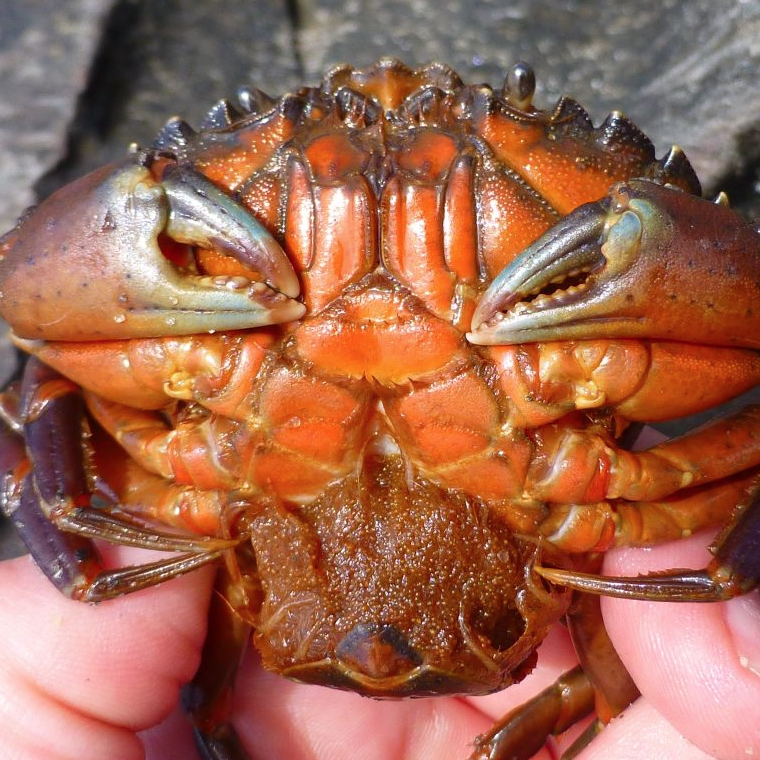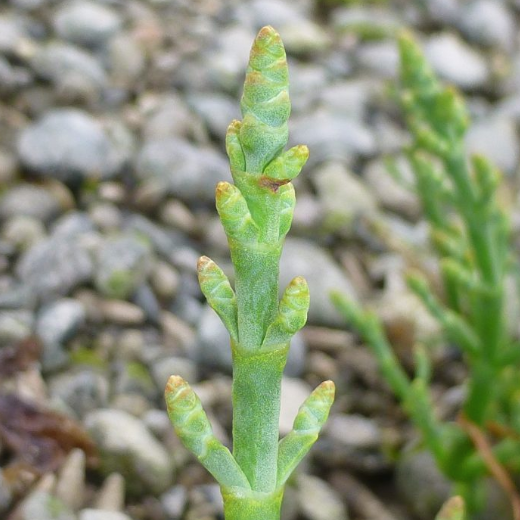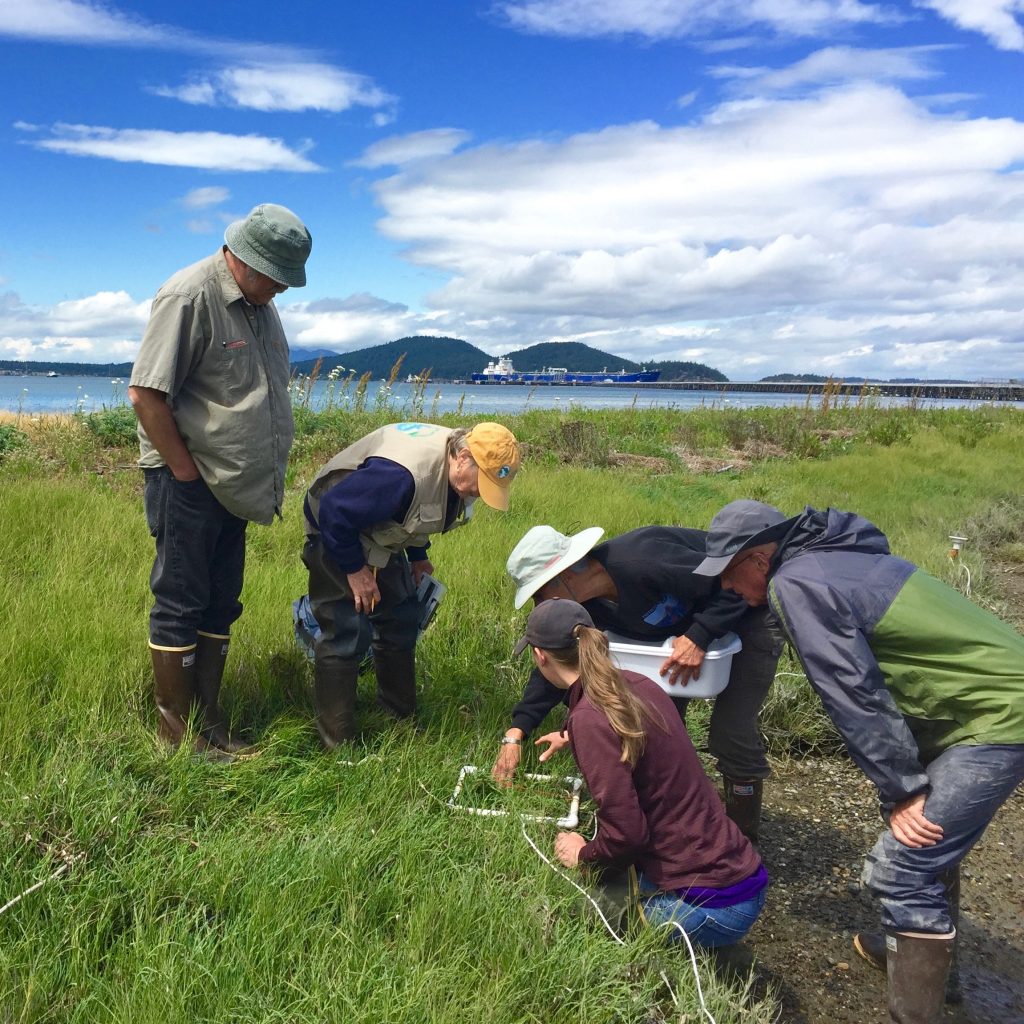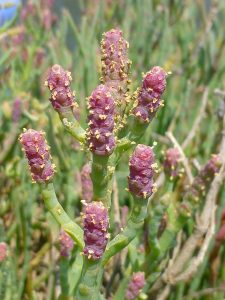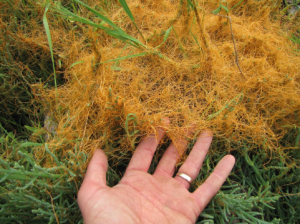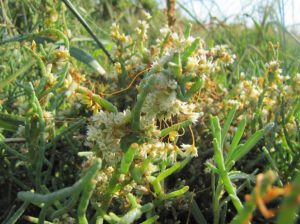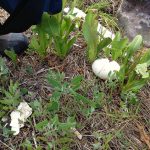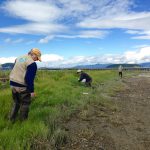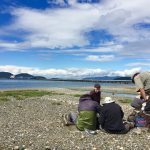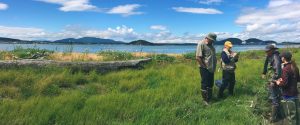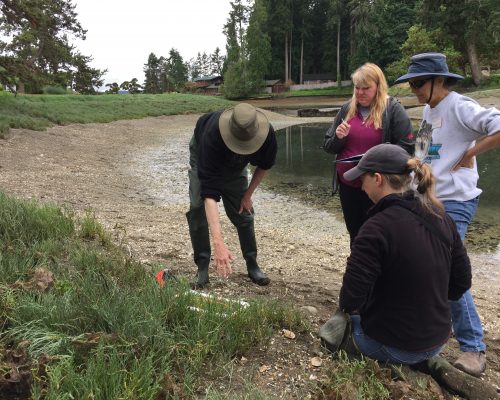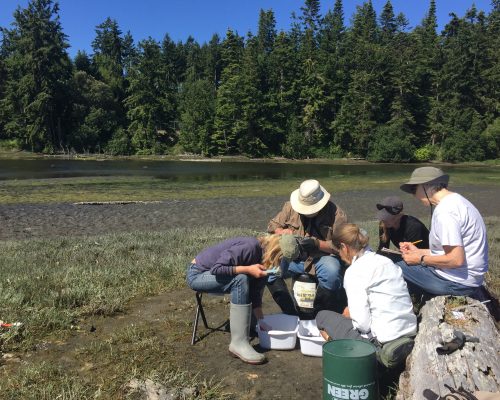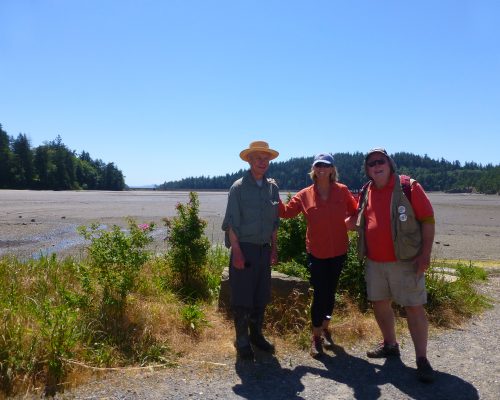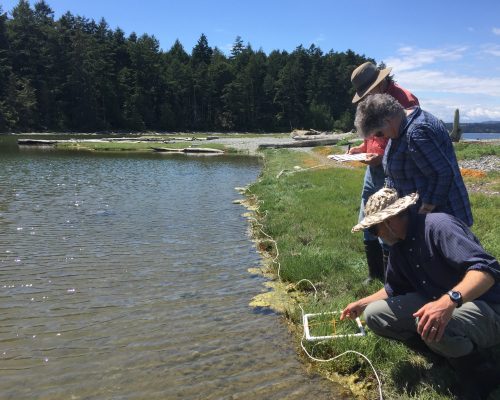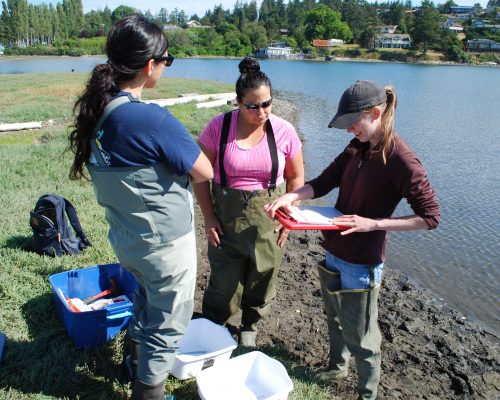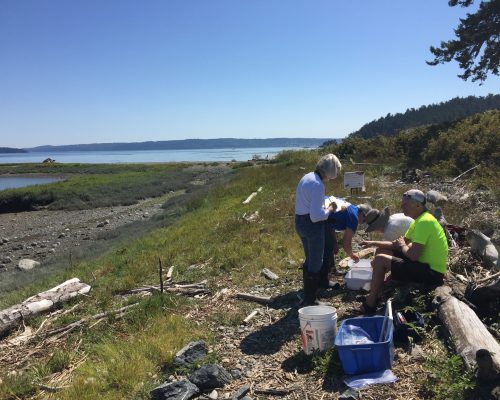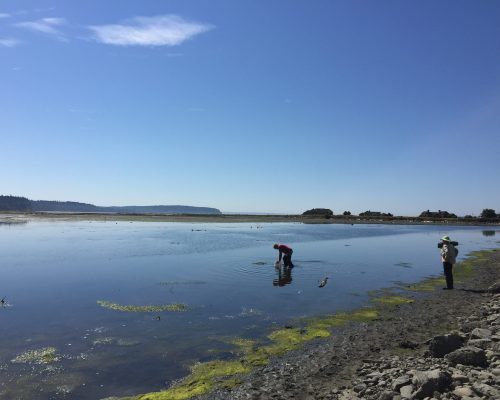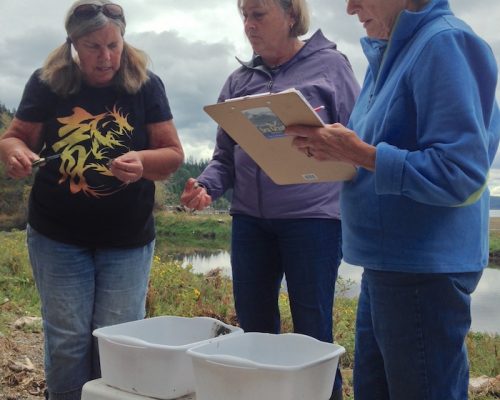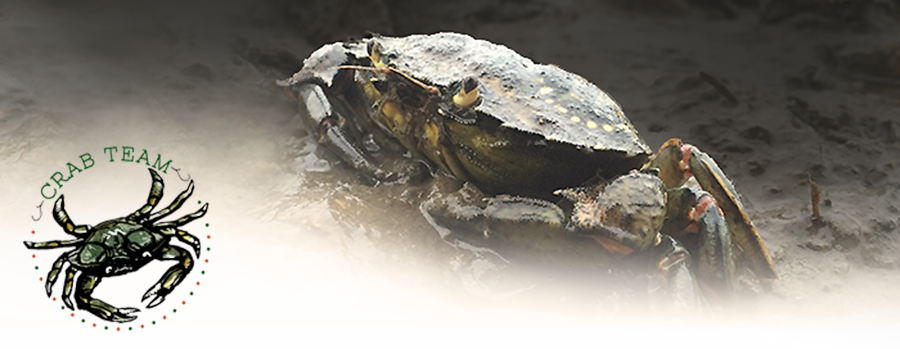
Summertime Crabbing
September 7, 2018
WSG Crab Team first piloted its monitoring protocols in August 2015, when 30 volunteers monitored 7 sites. This year, the program has grown to have 200 volunteers and 25 staff from partner agencies and area tribes out in the mud counting thousands of crabs across the network of 54 early detection sites. Thankfully, most of those crabs have been native species. So far this year, European green crab have continued to follow a similar pattern as last year: we have seen one or two European green crab pop up in a few new or familiar places, and a slightly larger number is being found at Dungeness Spit, where U.S. Fish and Wildlife Service continues to trap aggressively to remove as many crabs as possible (65 this year to date).
Our work here at HQ is to support the stellar efforts of the Crab Team monitors, and, in between managing the data coming in, we’ve been able to join in on sampling efforts at about half of our 54 sites this year. We have also been supporting efforts in Makah Bay on the outer coast, training managers in order to build capacity beyond Crab Team to effectively intervene in this invasion, and collaborating with managers and scientists from British Columbia to collectively manage green crab in the entire Salish Sea.
As we like to say, it takes more than just a village to protect the Salish Sea from damage by European green crab – in our case, it takes multiple nations! And so we’re so grateful to all of you for what you bring to the effort, as volunteers, supporters, ambassadors, or as beachgoers.
All our pinchy best,
Crab Team HQ
Green Crab: Ontogeny and Phenology
Here at Crab Team, we get asked a lot of questions about green crab. One of the most common is simply, “Where am I likely to find a green crab?” To answer that simple question, we have to provide a relatively unsatisfying answer: it depends. It depends on a number of factors but ontogeny and phenology are among the most important. Ontogeny refers to the changes that an organism undergoes as it develops over its lifespan, while phenology involves cyclic or seasonal patterns of natural phenomena changing throughout the year. These concepts interact in interesting ways to influence the real estate landscape for green crab. Indeed, ontogeny and phenology are critically important in considering where one might find green crab because … timing is everything.
You see, much like your kids heading to college and then striking out on their own, the place a green crab calls home changes over its lifetime (ontogeny). It all starts in the plankton.
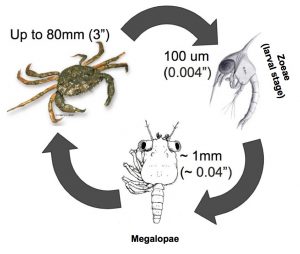
Life stages of European green crab. With adapted images from Greg Jensen (adult), Rice and Ingle (megalops), and Haeckel (zoea).
They Grow Up So Fast…
Larval green crab slosh around on ocean currents and rarely touch the bottom. This strategy keeps them as close as possible to their planktonic food sources and allows the species to spread to new locations. The open ocean is their first habitat, albeit a short-lived one, and they spend only a few months adrift. That’s because, like all arthropods, the developing larvae undergo a series of important metamorphoses, shedding their exoskeleton (molting) and changing the arrangement of their body features. With those changes, they shift what habitats they use. The current-loving larval stages (zoeae) give way to megalopae (the single of which is “megalops,” which is a pretty fun word to say). The megalopal stages are “thigmotactic.” Now, there’s a word to impress your friends with at cocktail parties! It means that they seek contact with another surface. The sole purpose of this stage is to find a suitable place to settle and make a living for the remainder of their crabby lives. Megalopae are better swimmers than their predecessors and have strong preferences for habitats that promote survival. During high tides they settle onto the upper shore of estuaries into marsh grasses, oyster or mussel beds, and other spots where they can hide from predators. Once they find a safe home, megalopae metamorphose again into baby crabs.
Over the next few months of life on the bottom, the baby green crab grow rapidly, taking advantage of fertile growing conditions in the relatively warm, very shallow water. At this vulnerable size, they live among the marsh plants, hunker down in shallow burrows, or hide in seagrass or shellfish beds. As the crabs grow, their increased size gives them a bit of protection from some predators, so they can move into slightly deeper water where there are better feeding opportunities. In some cases, these young green crab occupy saltmarsh channels or shallow lagoons, and as they grow even larger, they might move into shallow subtidal regions of estuaries.
Green Crab Maternity Homes
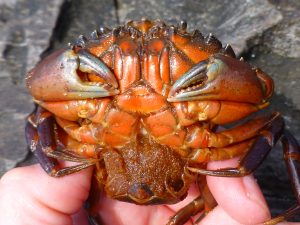
A green crab baby bump. This, female found in Maine, has turned quite orange with age, and is brooding her eggs under her abdominal flap. (Photo: E. Grason).
For female crabs, major life events lead them to choose a different habitat yet again. The process of extruding eggs onto the abdomen is a tricky one, and requires just the right conditions. Female green crab seek out sandy areas under rocks and other debris, then dig a shallow depression and use it much like a Jell-O mold to form the newly laid eggs against their body. A “berried” female carrying thousands of bright orange eggs is an easy target for many predators so brooding moms tend to stay buried and relatively sedentary as their eggs develop. Females prefer sand over gravel or mud during this time, likely because it’s easier to keep the eggs clean and well aerated. Note: scientists actually know relatively little about brooding female green crab because they’re so cryptic and difficult to find.
The Golden Years
The final ontogenetic shift in habitat occurs as green crab start to senesce. Most crabs reach what is referred to as a “terminal molt.” That is, they only molt a set number of times in their life. When they reach this stage, their last shell, which they will live in for the remainder of their lives, turns from green, to orange, and finally to red. These color changes are accompanied by changes in physiology and aggression. The older crab become less tolerant of fluctuations in temperature or variability in salinity. Consequently, old crabs tend to be found in slightly deeper areas and farther away from freshwater inputs like streams and rivers. You can read more about this in a previous newsletter article.
For Every Season…
These ontogenetic changes don’t occur in a vacuum. They’re timed to coincide with other natural phenomena so that crabs are “dialed in” to their surroundings as they change throughout the year. Thus, we observe phenological patterns – seasonal changes – in how crabs grow and where they are found. While not all of the triggers are known, seasonal changes in temperature and light level are important, as are the cyclic patterns of the tide. For instance, there’s evidence from some regions that female green crab time the release of their larvae with nighttime flushing tides in early spring. This timing gives their offspring a better chance of being carried out to sea when there is abundant planktonic food, like copepods, and currents are favorable for dispersal.
It’s not an accident that Crab Team monitoring corresponds with these seasonal and cyclical patterns, because seasons affect where and whether we are likely to find green crab. In the Pacific Northwest, green crab tend to be most active during the warmer spring and summer months (April – September). Crabs don’t keep a warm body temperature like we do, so their activity rates are strongly influenced by external temperatures, because warmer temperatures speed up biochemical reactions. Crabs have to take advantage of the warm parts of the year and cram in as much feeding, growing and mating as possible. That makes green crab “more catchable” at these times of the year, more eager to enter traps in search of food, and that gives us a better chance of finding them even if they are extremely rare.
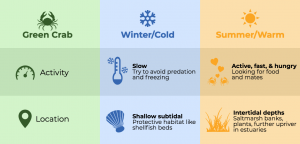 It’s not only activity level that changes with the season, but also the places where crabs are found. In the winter, air temperatures can get dangerously cold for green crab. In addition to slowing them down, making it difficult for them to get food and escape from predators, if crabs were to be out of the water when temperatures drop near or below freezing, ice crystals could form and damage their tissue. To avoid this, they spend more time in slightly deeper water during colder parts of the year. Green crab often migrate out of the intertidal zones and deeper into the shallow subtidal. They seem to take shelter in shellfish beds at these depths and are sometimes found by shellfish growers during this time of the year. We have also observed that as the spring rains abate, and the salty portion of river estuaries extends further and further upstream, green crab can also be found further upriver in the later summer than in the earlier summer.
It’s not only activity level that changes with the season, but also the places where crabs are found. In the winter, air temperatures can get dangerously cold for green crab. In addition to slowing them down, making it difficult for them to get food and escape from predators, if crabs were to be out of the water when temperatures drop near or below freezing, ice crystals could form and damage their tissue. To avoid this, they spend more time in slightly deeper water during colder parts of the year. Green crab often migrate out of the intertidal zones and deeper into the shallow subtidal. They seem to take shelter in shellfish beds at these depths and are sometimes found by shellfish growers during this time of the year. We have also observed that as the spring rains abate, and the salty portion of river estuaries extends further and further upstream, green crab can also be found further upriver in the later summer than in the earlier summer.
At sites like Makah Bay, on the outer coast, and Graveyard Spit in Dungeness Bay, where many green crab have been captured, we have had seen clear seasonal patterns of growth. We also see clear peaks in molting during early July and late August. The crabs are growing quickly and shedding their shells as they do during these months. Not surprisingly, we see some similar patterns in native species, too. Tracking seasonal patterns is useful for understanding the dynamics of these populations. And just like tracking the flowering date of the cherry trees here on the University of Washington campus, or sighting of the first migrating snow geese in the Skagit Valley, observations of green crab phenology can provide scientists with insights into how climate change could affect local ecosystems and the invasions that threaten them.
– Sean McDonald
Species Name: good question… maybe Sarcocornia perennis
Size: Up to 30 cm tall
Distinguishing Features: Mat of dead-looking brown stems in winter; succulent, fleshy, green, oppositely branched plant with scales rather than leaves through the growing season; club-like and often colorful flower spikes at the end of stems have super tiny flowers arranged in groups of three.
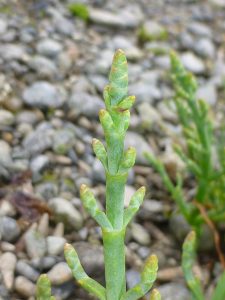
The Name Game
We’re going to be flexible with our definition of “creature.” Since one-third of our protocol has very little to do with animals, we figured the plants deserve some love too! And what better flowerphile to start with than pickleweed (Sarcocornia/Salicornia).
There doesn’t appear to be any certainty around what scientific name/s to ascribe to our local species. The Burke Museum calls the perennial pickleweed (which dies back to a mat of brown stems every winter) Sarcocornia perennis, and the annual pickleweed (which dies back completely and returns from seed or taproot) Salicornia depressa. The perennial pickleweed seems to be called pacifica in British Columbia and California or maritima sometimes because, well, why not. Of course, Salicornia virginica is widely used in seashore guides and plant texts for our region to describe pickleweed. Even the family name is not free from scientific uncertainty. To avoid this “taxonomic nightmare,” as it has been called by scientists, we’ll call it all … pickleweed.
Of course, settling on a common name hasn’t gone much better. Pickleweed, sea beans, sea asparagus, samphire (evolved from “Saint Pierre,” patron saint of fishermen), glasswort and saltwort seem to all be contenders for describing pickleweed species. There’s also chicken claws and crow’s feet, which are my new favorite names, as they’re pretty descriptive of pickleweed. The first three names in the list reflect the fact that pickleweed is edible and consumed around the world. To do so yourself, harvest the fresh green parts of the plant from unpolluted areas, blanch them for a minute in boiling water (no salt), shock them with ice water, then eat them or use them in some awesome dish you found by searching “sea bean recipe” online. Nibble them raw too. I find them succulent and salty with just a bit of bitter.
The name glasswort started about 500 years ago. Pickleweed was burned to ash so the sodium carbonate within could be used as one of the three main ingredients in a new glass-making process that would dominate production for centuries to come. Now pickleweed is being used or considered for use in bioremediation of pollution, biodiesel, animal feed, paper production and as a treatment for a number of health issues.
Sea Shore Superstar
Since it is an abundant, rooted, halophyte (salt-loving plant) that lives lower in the intertidal than most other shoreline plants, pickleweed plays a really important ecological role. Its roots provide some stability and structure, while its stems further dampen waves during high tide in the already low energy environments in
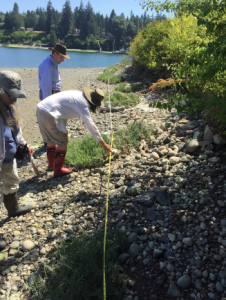
Shoreline monitoring volunteers (serendipitously also members of Crab Team!) Niki Quester, Bob Webb, and Marge Widmeyer helping collect data on pickleweed planting experiment at a large private shoreline restoration site on Bainbridge Island. Photo: J. Adams
which they like to grow. Maybe most importantly, they provide a cool, damp, shaded hideout for beach creatures. It’s not unusual to find shore crabs, beach hoppers, barnacles, three kinds of snails and more under and on pickleweed.
Pickleweed species can grow in salty soils inland as well. Their adaptation to dealing with so much salt, which would be otherwise toxic, is pretty cool. Some salt is filtered out at the roots, but salt that gets into the plant is dealt with by pumps within each cell that gather salt and send it to a storage area in the cell called a vacuole. When the vacuole has reached its limit, the cell dies and a new cell takes over. Thank the vacuoles for the saltiness of this succulent.
Even though it’s a halophyte (“salt-lover”), apparently pickleweed can be grown indoors or take root in your garden, though it might lose the salty flavor. Sounds like a gardening project for next winter or spring! That also reminds me of an experiment Jim Brennan, then with Washington Sea Grant and now with Marine Ecological Consulting Services, undertook at a large scale private shoreline restoration. He dug a shallow trench at a tidal elevation a couple feet below mean higher high water. Then, he alternated stretches of trench with chopped up pickleweed placed along the bottom with bare stretches, then backfilled the trench. Monitoring continues, but six years later, the pickleweed has grown up nicely where planted, though it remains patchy. While pickleweed is a fairly effective colonizer on its own, the same approach could be used at other locations as an inexpensive way to jumpstart pickleweed where it had been lost or reduced as a result of shoreline modification.
Several lovely little plants, including jaumea, saltgrass, seaside plantain and spurrey, are also part of the community pickleweed dominates.
- Marsh jaumea (Jaumea carnosa) is fleshy with leaves and relatively large,
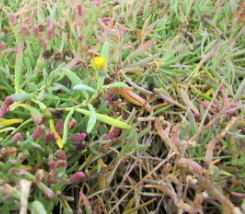
The pickleweed community, including jaumea (with the yellow flower) and saltgrass (grass on the lower right). Photo: J. Adams
bright yellow flowers. It’s hard to miss when it’s in bloom.
- Saltgrass (Distichlis spicata) is a short, stiff grass whose blades are largely on a single plane. Instead of storing salt like pickleweed, saltgrass secretes the salt through glands to the surface of the leaves. You can often see salt crystals on the blades if you look closely.
- Seaside plantain’s (Plantago maritima) flowering stem looks like those of the plantain species that may live in your yard, but the leaves of seaside plantain are narrow and fleshy, almost like long, skinny aloe leaves.
- Spurrey (Spergularia salina) is usually not very obvious, but it’s adorable enough to get a mention.
… Oh, and then there’s salt marsh dodder.
Orange Spaghetti Vampire
Since we’re talking about pickleweed, the favorite host for parasitic salt marsh dodder, it seems fair to give this awesome parasite a nod. There are a bunch of different dodders in Washington, but the main one entangled in the pickleweed community appears to be salt marsh dodder (Cuscuta pacifica… or salina… bah).
Dodder is a parasitic member of the Convolvulaceae, which includes morning glory and sweet potato. It is unable to perform photosynthesis or obtain any of its own water or nutrients. The dodder grows from seed each year, rooting briefly in the ground until it has attached to a host. At which point, the root is rendered unnecessary and dies back. The dodder then wraps around and up and all over the host and its neighbors, piercing stems with structures called haustoria that anchor the dodder while providing the conduit through which they siphon off goodies.
But I’ll be darned if this brilliant string doesn’t produce the cutest and most abundant little flowers! Especially when compared to pickleweed’s invisibly tiny flowers. Then again, pickleweed did do all the work to provide the energy for dodder to make the flowers. Shouldn’t it be able to claim the flowers as an attractive product of its own labors? Maybe, but the bling isn’t necessarily worth it to the pickleweed.
The salt marsh community as a whole, on the other hand, may be celebrating their rootless hero. Dodder doesn’t seem to cause mass mortality of pickleweed, but the effects can be strong enough to create opportunities for less abundant species to occupy more habitat. That means the presence of dodder can increase the diversity of the salt marsh, playing a role not unlike the purple sea star’s keystone predation, which can create more diverse rocky intertidal communities. Way to go little orange thread! Power to the parasite.
–Jeff Adams
“I am certain that there’s a joke in here somewhere about getting ‘goose eggs’ during our molt hunt!” I had a chance to visit Crandall Spit in May to help the team of volunteers look for European green crab, but we got sidetracked by some decidedly non-crabby natural history – a couple of huge, white empty eggshells in the wrack line. I was up in Fidalgo Bay, near Anacortes, along with Crab Team program assistant, Kelly Martin, to work alongside Crab Team volunteers and keep abreast with the latest developments in the field. Getting us out of the office and into the mud on a gorgeous day didn’t hurt either!
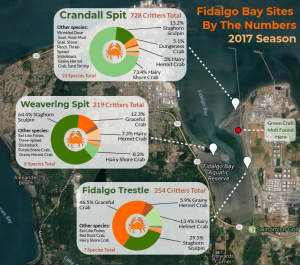
Map of Crab Team sites in Fidalgo Bay and the critters found in traps in 2017 at each site. Graphic: Kelly Martin. Click to enlarge.
According to the Crandall Crabbers, the eggshells we found that day might have come from a nesting pair of Canada geese that have been known to set up shop on the spit. Last year, the geese were a bit of an obstacle to sampling. Evidently one time, the path to the site led the team right up to their nest, and they were all chased off by the pair. “With water on one side and hip-deep mud on the other, we had no option but to try to sneak by while the geese were off their nest. We were just starting to congratulate ourselves on our success when the attack happened. With a lot of arm waving, coupled with a mad dash, we made it through the battle zone without any bloodshed. Needless to say we found an alternative route for next time,” recounts Pattie Hutchins.
Encounters like these also remind us that the salt marshes and pocket estuaries monitored for European green crab are not only important for marine critters like crabs and fish, but also for other wildlife, particularly migratory shorebirds (we also saw Caspian terns and oystercatchers that day, thankfully not protecting their nests).
Crandall Spit is one of three Crab Team monitoring sites in Fidalgo Bay (see map). You might have heard about Fidalgo Bay recently because a molt from a European green crab was found just south of Crandall Spit, leading to increased trapping activity in the area. Up to that point, no evidence of green crab had been detected in Fidalgo Bay, even though there are several sites in the area. Thankfully, additional exploratory trapping by Washington Department of Fish & Wildlife has failed to yield any further evidence of green crab in Fidalgo Bay.
It’s relatively uncommon to have multiple sites so close together in the Crab Team network of early detection sites. But the high site density in Skagit County occurs largely because of the intense concern focused on European green crab in Skagit County, following the detection of four crabs in adjacent Padilla Bay in 2016. Crandall Spit was launched as a Crab Team site in 2016, but the other two sites, Weavering Spit and Fidalgo Trestle, were launched in 2017. That year, the Skagit County Marine Resources Committee obtained a grant from the Northwest Straits Foundation to purchase monitoring equipment for participation in Crab Team early detection, enabling Crab Team to grow from 2 to 11 sites in Skagit County, and support monitoring in other MRC counties as well.
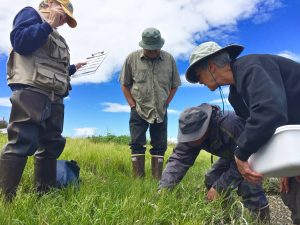
Crandall Spit volunteers L to R: Pattie Hutchins, Gordon Sjogren, Tom Flanagan, and Sue Russell. Photo: Kelly Martin
Even though the three monitoring sites in Fidalgo Bay are relatively close together, they are surprisingly different in what they catch in traps. Crandall Spit traps are dominated by hairy shore crab, while Weavering Spit catches more staghorn sculpin than anything else, and the Fidalgo Trestle site gets primarily graceful crab. These differences in the ecological communities among the three sites show us that even sites close to each other can be different because of small details about the habitat. Crandall Spit is more enclosed and protected than the other two sites, which might at least partly explain the relative success of hairy shore crab there.
We are fortunate to be able to include Crandall Spit in our network, not only because it is such a great monitoring site for early detection of green crab, but also because it is owned by Shell Oil, one of the two companies that own refineries on March’s Point, the peninsula that separates Fidalgo and Padilla Bays. Tom Flanagan, a volunteer Crandall Crabber, comments on how special the place is, “You just can’t wander out there if you feel like it. Access is tightly controlled, so in many ways it has a pristine character.” Shell has supported green crab monitoring in the area over the past several years, not only by helping volunteers access Crandall Spit, and other sites, but also helping fund green crab monitoring work in the region. “Although I have personal concerns about our society’s reliance on oil and the carbon footprint, I am grateful to Shell for participating in citizen science in this way. It reminded me that no issue is just black and white,” says Sue.
What are the Crandall Crabbers’ secrets to successful sampling? Sue says that it can work particularly well to balance variety with specialization. While everyone on the team has particular strengths, aptitudes, and interests, it can also keep things fresh to take turns at each of the tasks, rotating through each part of the protocols to experience the big picture.
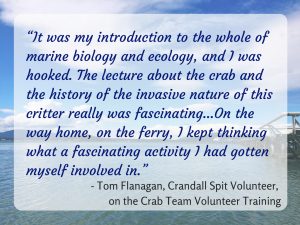 Leadership and decisiveness are also assets to a fun experience. Team member Tom Flanagan says that Captain Sue, “is good at making sure that we all have a chance to do all the tasks that are required and that nobody gets put in a position that they find untenable. It makes the job both challenging and interesting.” One member of the team has turned out to be adept at adjudication of estimates for the transect survey. At each quadrat, says Sue, “he listens to the others banter back and forth about percent cover of this and that, then takes in the ‘big picture’ of the quadrat contents. If the rest of us don’t come to consensus on a certain observation, we look to him and he weighs in on the final decision.”
Leadership and decisiveness are also assets to a fun experience. Team member Tom Flanagan says that Captain Sue, “is good at making sure that we all have a chance to do all the tasks that are required and that nobody gets put in a position that they find untenable. It makes the job both challenging and interesting.” One member of the team has turned out to be adept at adjudication of estimates for the transect survey. At each quadrat, says Sue, “he listens to the others banter back and forth about percent cover of this and that, then takes in the ‘big picture’ of the quadrat contents. If the rest of us don’t come to consensus on a certain observation, we look to him and he weighs in on the final decision.”
True to form, on the day that we visited Crandall Spit along with volunteers, Gordon, the adjudicator was able to keep us all on track – even when we were distracted by bird eggs or the beautiful views of Lummi and Guemes Islands to the north. As a closing thought, Sue wanted us to share how great it is to be a Crandall Crabber, “I love our team. Everyone is enthusiastic, responsible, and fun to be with. We joke and have some good laughs while we are doing our work.” Even though Crab Team sampling is mostly focused on crabs (and maybe sometimes fishes, shrimps, or even snails), it’s people that make it work.
-Emily Grason
Feature Photo: The Crandall Spit team working through the transect survey with Crab Team program manager, Emily Grason. Photo: Kelly Martin
Photo Gallery
We love to get the virtual experience of monitoring with all of the Crab Team volunteers. Do you have a photo to share? Send it to crabteam@uw.edu. (Click on arrows to scroll, and photos to enlarge for more detail.)

